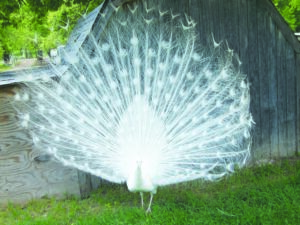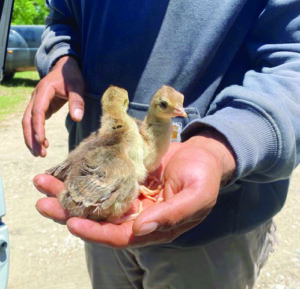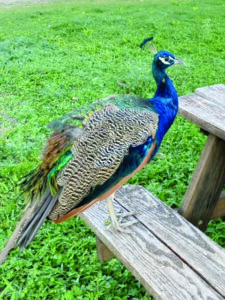FLAG POLE HILL
By Judy Babb
To folks who live near the White Rock Stables at the top of Flag Pole Hill, it’s not only the neigh of horses and the clatter of their hooves they expect to hear.

Photo by Nancy Black
For about the last 50 years, a flock of peacocks, more correctly called peafowl when speaking of both the males and females (we’ll call them peacocks here), roamed the nearby neighborhood. Then stable owner Tex M. Odder Sr. brought the birds in. Odder is remembered often as his family, who still own the stable, sees the white peacock that symbolizes his gift to Dallas. There were six white birds up until this year. The staff doesn’t know what happened to five of them, although it could have been a bobcat or a coyote.
Now the flock is made up of about 60 breeding pairs, stable manager J. Amilita Facchiano said. There are eight babies this year. The low numbers could be the result of the females laying their eggs in inhospitable places — like on the roof of a neighborhood home.
While peacocks are normally fairly quiet, in the spring, during mating season, they squawk quite loudly. That’s also when the males are most likely to show their colors, fanning their tail feathers. Their nightly search for their tree in which to perch is loud enough to garner some attention as well.
The peacocks get quite a few visitors — people who drive into the neighborhood to see them, often throwing sugar and chicken scratch for them. Neither is good for them, said Facchiano, who has a Ph.D in equine microbiology and has become an expert on peafowl as well.

Photos by J. Amelita Facchiano
“They need a stable diet to survive,” she said. They get that around the area.
She explained that healthy diet includes things the birds get near the stables: grass and seed they pick out of horses’ fecal matter, bugs they peck at on the ground, rat snakes and oily sunflower seeds.
They have flourished without care from the stables or people in the neighborhood. Peacocks don’t require care. They eat just about anything from plants to insects and lizards.
They don’t wander far, perhaps a couple of blocks into the neighborhood at the top of Flag Pole Hill. Neighbors there don’t plant flowers in their front yards, knowing the birds will eat them. Other than that, most say the neighbors don’t pay much attention to them.
Coby Manning has lived in the area since 2006. He said there are no cons to the birds being in the neighborhood. He said that having the birds in the neighborhood brings in some traffic as people drive in to see them. He said that sometimes they throw out bird seed, not realizing the birds live off the ample open land nearby.
“They are the dumbest creatures you’ll ever meet,” Manning said. “They walk the streets and are too dumb to move.”
While the peacock didn’t make the list of the top 19 dumbest animals, they probably would rank No. 20, right behind the turkey. Fortunately, most of their human neighbors pay them little attention other than making sure what they plant in their front yards isn’t what the birds would like to munch on.
The birds wander the area with aplomb, finding comfy spots in the yards, flower pots and on porches.
Manning said the biggest issue was their poop staining their sidewalks and porches.
Neighbor Trey Lahse agreed with Manning.

“They are relatively benign until they leave a mess on your doorstep,” Lahse said with a glance at his porch covered with stains from their white poop. “They also keep the neighborhood safe by slowing down traffic.”
The birds can provide some humor for the neighborhood. Manning said that a car with a shiny bumper provides a mirror for the birds who will then fight with their reflection.
Kimberly Chumlea, a frequent visitor to the area as an interior designer, chuckled about their behavior during the occasional freezing days of winter. “They’ll get on the roof and any water on their wings freezes,” she said. “They’ll try to fly down and crash into the yard —kerplunk.”
She also told a story about her and the house owner being downstairs when they heard noise upstairs in a yet-to-be closed-in bedroom. “We went upstairs and there were four or five of them in the front bedroom,” she said. “They left quickly.”
Neighbor Bettie Tully is one who professes love for the peacocks. She looked at the two that were claiming their spots, first on her front porch railing and then on her porch.
Tully has been adopted by the pair that have laid eggs on her porch and had babies there. They now return yearly to build their nest. As the peachicks grow, they go off with the mom, but she also brings the growing youngsters back to teach them a lesson.
“They come back and bring them to the glass front porch door,” Tully said. “She teaches them to look at themselves.”
That would make them as vain as a, well, peacock.
